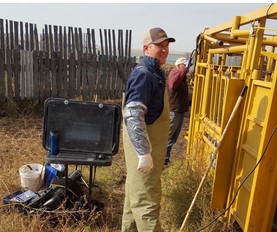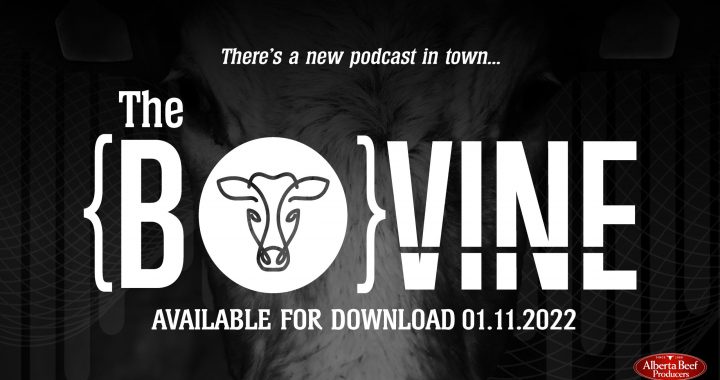There’s the traditional way of doing things, and there’s the new (usually more effective/informative) way. Dr. Waylon Wise of Cow/Calf Health and Management Solutions (CCHMS) explains both as they relate to bull breeding soundness evaluations (BBSEs) and DNA strategies.
“A traditional herd-health relationship starts with discussing health.” says Waylon, “Once we get this streamlined, the next discussion is usually about how to use the ranch resources most effectively, improve performance, replacement selection etc. That leads to which bulls to buy, how to evaluate the success of them during breeding season, and what works best with the genetics and the environment on the ranch.”
Once pre-pubertal bulls are in the sale pen, vets like Waylon end up seeing them at the business end of a probe for semen testing to evaluate “potential competency” (note, this is NOT a measure of fertility). The goal here is to find the ones that are unfit for sale; it’s a pass or fail test. That said, passing a semen test as a 12-month old bull is like saying “if you graduate high school, you will automatically thrive in the real world.” We all know this isn’t true. Context matters. So passing isn’t the be all and end all of anything.
The main components of a BBSE (BBSE image) are the physical exam, palpation of testicles and internal sex glands, measuring scrotal circumference and evaluating the motility and structure of the sperm cells. The latter is tricky. For starters, it’s hard to perform (for the bull and the sperm) on a cold day (most bull sales are in the dead of winter); nervous bulls don’t respond well to the probe; and a variety of stressors (including being semen-tested) reduces semen quality. Not to mention that high growth rate and superior performance may delay the onset of puberty. There’s a reason why the last bull in the sale order rarely fails a semen test!
“There’s enormous unjustified pressure on these young bulls to pass a semen test,” says Waylon, “but there are too many variables to cast the results in stone. Of the physically normal pre-pubertal bulls that we pursue retesting on, 95-97% will eventually pass and be fertile.”
Large scrotal circumference in pre-pubertal bulls doesn’t mean they are more fertile, produce more calves or more weaning weight. In fact, excessive scrotal circumference (more than 40 cm) in pre-pubertal bulls may delay the onset of puberty—so it may take them longer to pass a semen test. Bulls with a smaller scrotal circumference may be just as fertile. It’s not uncommon for a young bull to gain 3, 4 or even 6 cm (!!) as he reaches puberty. If you don’t like your guy’s measurement one day, just wait a week or two.
And at the end of the day, a physically normal bull that fails a semen test or has sub-optimal scrotal circumference can sire as many calves as bulls that pass. We have the evidence. The opposite is true also. Bulls with exceptional semen quality can fail to earn their keep.
There are also welfare implications of sending 20V of electricity into the rectum to stimulate ejaculation, or injuries that occur in the chute and the unnecessary trauma to the penis by unnecessarily breaking a pre-pubertal, normally-occurring frenulum.
“We’ve already started to shift the paradigm around pre-pubertal bulls, and we need to keep educating young vets about the pitfalls of doing this so early in a bull’s life,” says Waylon. “Bulls should still be palpated, measured and evaluated in the chute prior to sale to remove the physically abnormal ones. But basically, you should be buying a bull based on his merit and what value he adds to your genetic program. The semen test of the BBSE is of minimal value.”
So there IS a better way! Use the power of DNA.
First, all potential sires must have a DNA Case Number (the animal’s universal DNA tracking number: this is the “name” of the DNA record or genotype). The majority of purebred sires will already have a genotype on file at the breed association. The vet verifies this during the BBSE and collects hair or tissue if needed. The sample barcode is scanned into Herdtrax, and the submission file is generated and sent to Neogen for processing. Once the file comes back, it’s uploaded and will automatically link the genotype to the animal’s record. This takes 4 – 6 weeks. Even if the animal is gone, you can use semen in the tank—or meat in the freezer!
To acquire parentage, the vet collects a sample from the calf (usually at branding or weaning), scans the barcode, adds the potential sires and the submission file is generated and sent to Neogen, then returned for upload. The upload will assign the sire and indicate it’s verified.
So the DNA strategies are:
• DNA all calves. Index all the bulls by number of progeny, daily service capacity, weaning weight, weaning ADG (WADG), carcass traits and total lbs produced during a breeding season.
• DNA replacements. Identify the sires who produce the calves that thrive in the current environment. These calves have been selected on data and, in some cases, produce the phenotype desired at the ranch.
• DNA Potential AI sire. Gestation can vary by +/-16 days. Keep replacements from the AI sire when clean-up bulls are used immediately after insemination.
• DNA poor calves/ dystocia. Fertility is not the only parameter. Cull bulls who dilute the gene pool with unfavourable genetics or cause undesirable outcomes.
• DNA herds. Heads-up test-breeding of groups of bulls with similar breed, pedigree or source.
Test within same herd or pasture location to evaluate:
- Sires that work best to maximize heterosis in different herds (breed composition)
- Sires that thrive in different pasture locations, nutrition (forestry vs native grass)
- Sires that thrive within the terminal (low-index) vs maternal herd (high-index)
“Then repeat the trends that work,” says Waylon.
-
-
- Only use progeny from proven, superior bulls and cows for breeding.
- Use proven, superior bulls on the high-index herd to produce your own replacements. Collect semen and AI within your own herd prior to bull turnout.
- Send individual bulls with superior progeny performance out for the first cycle.
- Use sires with proven carcass traits on low-index terminal cows.
- Cull and replace individuals in the bottom 10%.
-
Yes, it’s complicated, and there needs to be an integrated approach to evaluating bulls that includes a thorough physical exam, selective semen testing of questionable or unproven pubertal bulls, and using DNA parentage to index the performance of their offspring.
“Even today, with advances in DNA technology and enhanced traceability through online and chute-side management programs such as Herdtrax, we still rely too much on a stand-alone semen test in an off-season that is not that correlated to actual fertility, performance or the bottom-line,” says Waylon. “It’s time for a change.”




